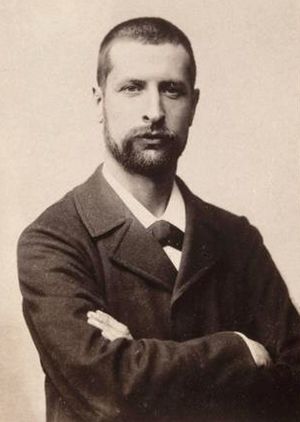Alexandre Yersin facts for kids
Quick facts for kids
Alexandre Yersin
|
|
|---|---|

Alexandre Yersin
|
|
| Born | 22 September 1863 |
| Died | 1 March 1943 (aged 79) Nha Trang, Annam, French Indochina
|
| Nationality | Swiss and French |
| Known for | Yersinia pestis |
| Awards | Leconte Prize (1927) |
| Scientific career | |
| Fields | Bacteriologist |
| Institutions | École Normale Supérieure, Institut Pasteur |
| Influences | Kitasato Shibasaburō |
Alexandre Emile Jean Yersin (born September 22, 1863 – died March 1, 1943) was a Swiss and French doctor and scientist who studied bacteriology. He is famous for helping to discover the tiny germ that causes the bubonic plague. This germ was later named Yersinia pestis in his honor.
Another scientist, Kitasato Shibasaburō from Japan, also found a similar germ around the same time. However, Yersin's discovery was clearer. Yersin also showed that the same germ was found in both sick rodents and sick humans. This was a big clue about how the disease might spread.
Contents
His Life and Discoveries
Early Life and Learning
Alexandre Yersin was born in 1863 in Aubonne, Switzerland. His parents were French. He studied medicine in different cities, including Lausanne, Switzerland, and Paris, France, from 1883 to 1886.
In 1886, a famous scientist named Louis Pasteur invited Yersin to work in his research lab. There, Yersin helped create a treatment for rabies. He also worked with Émile Roux and together they discovered the toxin (poison) produced by the germ that causes diphtheria.
To practice medicine in France, Yersin became a French citizen in 1888.
Adventures in Indochina
In 1890, Yersin moved to French Indochina (which is now Vietnam, Laos, and Cambodia) in Southeast Asia. He worked as a doctor for a shipping company. He traveled a lot, exploring new areas.
In 1894, the French government and the Pasteur Institute asked Yersin to go to Hong Kong. There was a serious outbreak of the plague happening there.
Discovering the Plague Germ
When Yersin arrived in Hong Kong, he was not allowed into the British hospitals. So, he set up a small lab in a hut. It was there that he made his most important discovery: he found the germ that causes the plague.
Another doctor, Kitasato Shibasaburō, also found a bacterium a few days earlier. There was some debate about who found it first or if they found the exact same thing. However, Yersin's lab was cooler, which was better for growing the plague germ. This helped him in the race to identify it.
Yersin was also the first to show that the same germ was found in both sick rodents and sick humans. This was a very important step in understanding how the plague spreads. His discovery was shared with the French Academy of Sciences that same year.
Fighting the Plague and New Ventures
From 1895 to 1897, Yersin continued his studies on the bubonic plague. He returned to the Pasteur Institute in Paris and helped create the first anti-plague serum (a type of medicine).
He then went back to Indochina and set up a small lab in Nha Trang. This lab later became a part of the Pasteur Institute. Yersin tried his new serum in different cities, but it did not work as well as he hoped.
Yersin decided to stay in Indochina, which he loved. He helped start the Medical School in Hanoi in 1902 and was its first director.
Yersin also became a pioneer in agriculture. He started growing rubber trees, which he brought from Brazil to Indochina. He also tried to grow quinine trees. Quinine is a plant that helps treat and prevent malaria, a common disease in Southeast Asia.
Legacy in Vietnam
Alexandre Yersin is still very well-remembered in Vietnam. The local people lovingly called him Ông Năm (Mr. Nam or Mr. Fifth).
In 1902, Yersin became the first headmaster of the Hanoi Medical University. Even after Vietnam became independent, streets named after him kept their names. His tomb in Suoi Dau has a pagoda where people honor him. His house in Nha Trang is now the Yersin Museum. The words on his tombstone call him a "Benefactor and humanist, venerated by the Vietnamese people." A French high school in Hanoi and a university in Dalat are also named after him.
In 1934, he was made an honorary director of the Pasteur Institute. He passed away in 1943 at his home in Nha Trang during World War II.
Miscellaneous
Dr. Yersin is also known for finding the location for the new town of Dalat in 1893. Because it was high up and had a climate like Europe, Dalat became a popular place for French officers to relax. There was a high school named after him, built in the 1920s, and a university built in the 2000s.
While in Hong Kong, an Italian priest named Bernardo Vigano helped Yersin with his research. He provided bodies for study and helped Yersin in his search for a cure for the plague.
See also
 In Spanish: Alexandre Yersin para niños
In Spanish: Alexandre Yersin para niños

